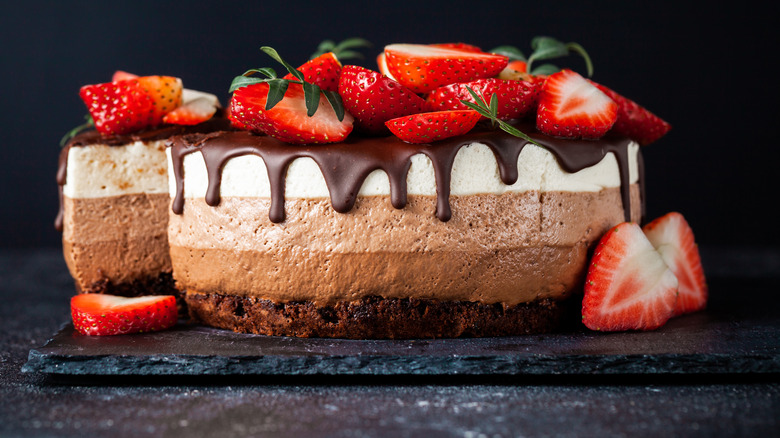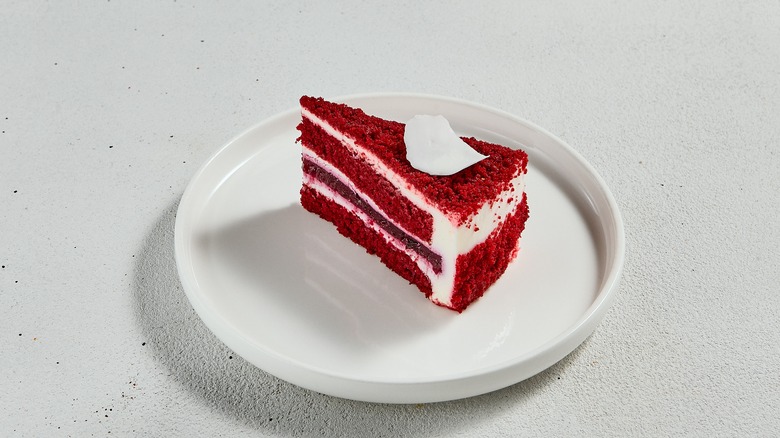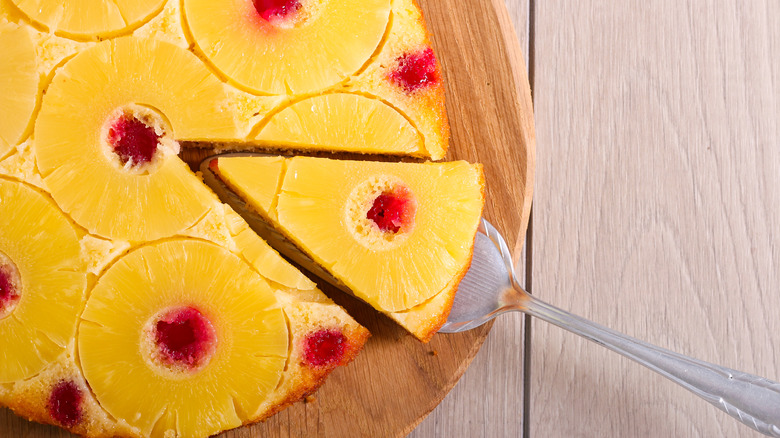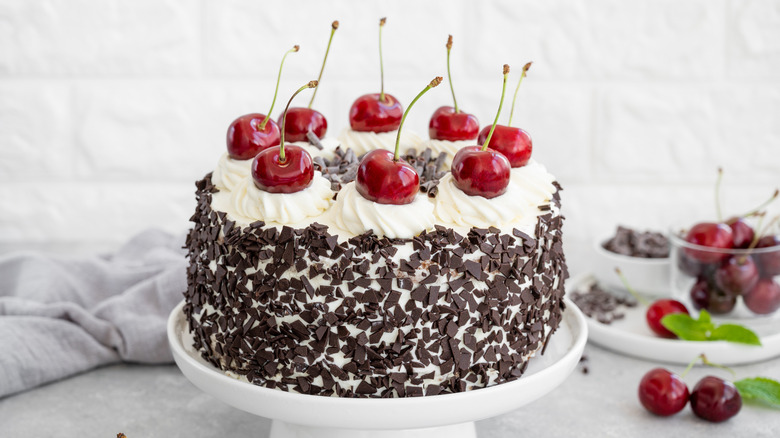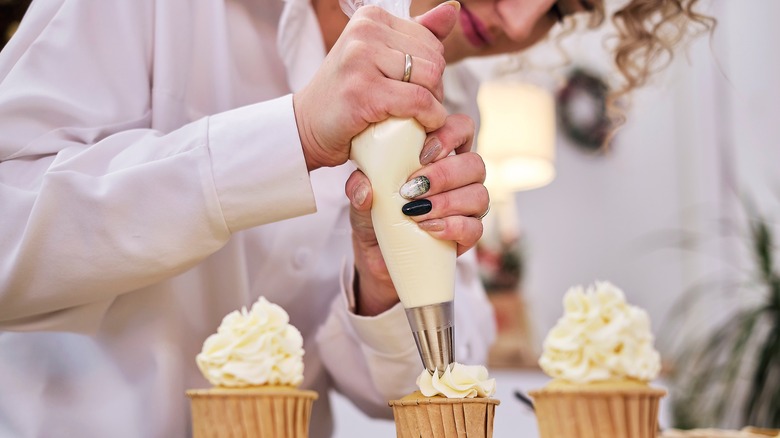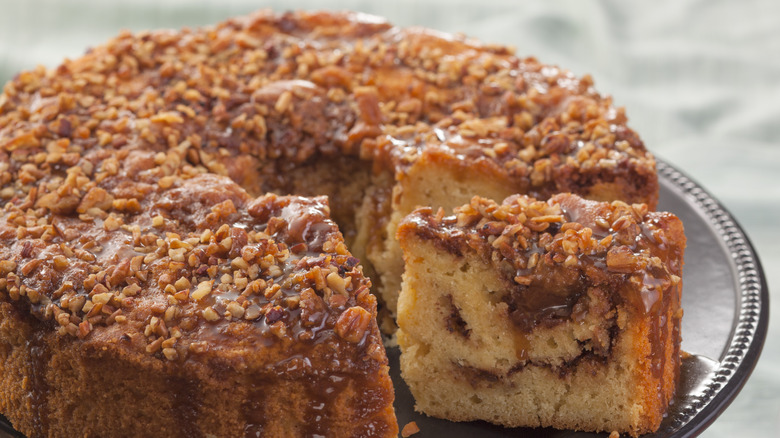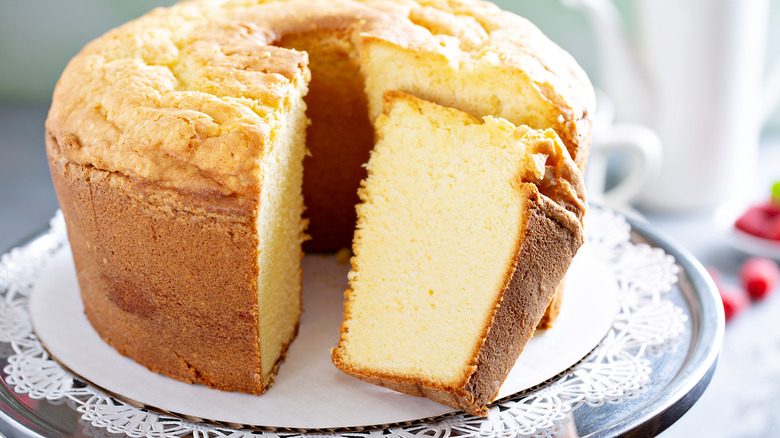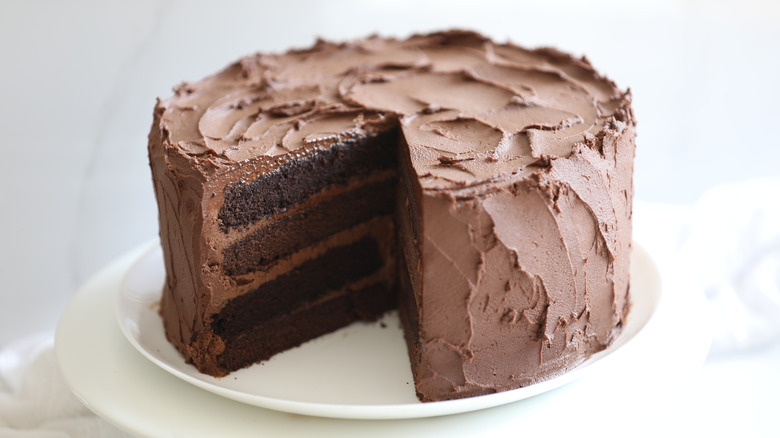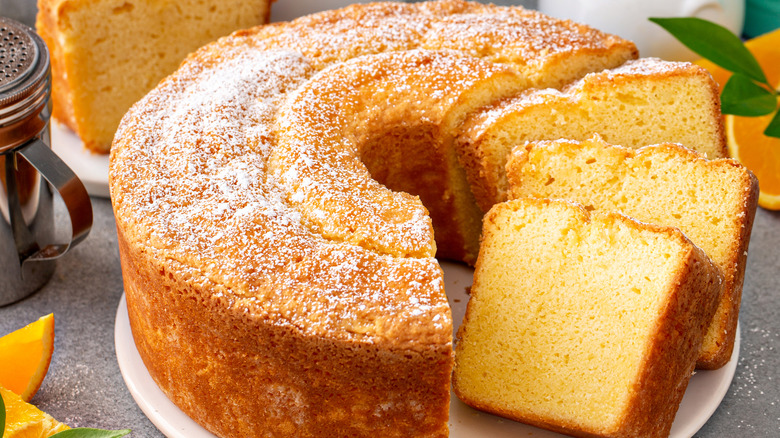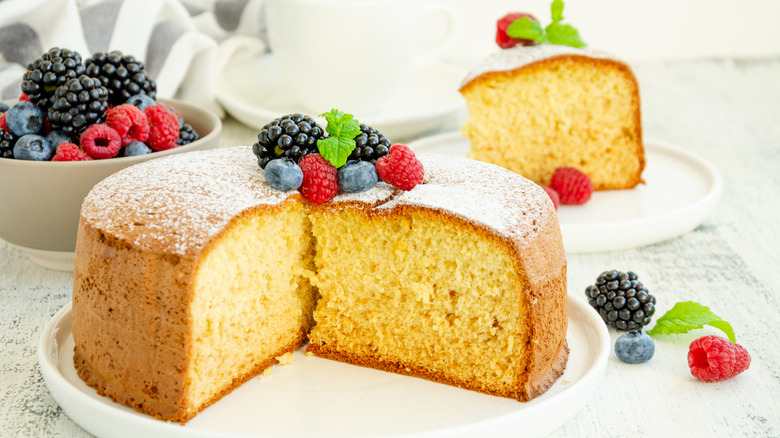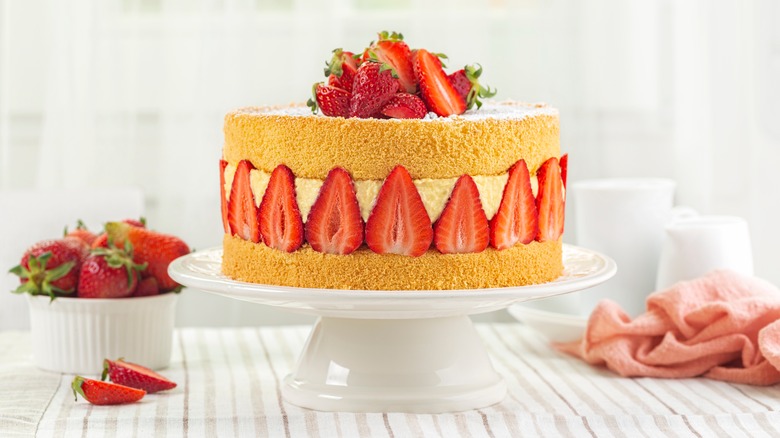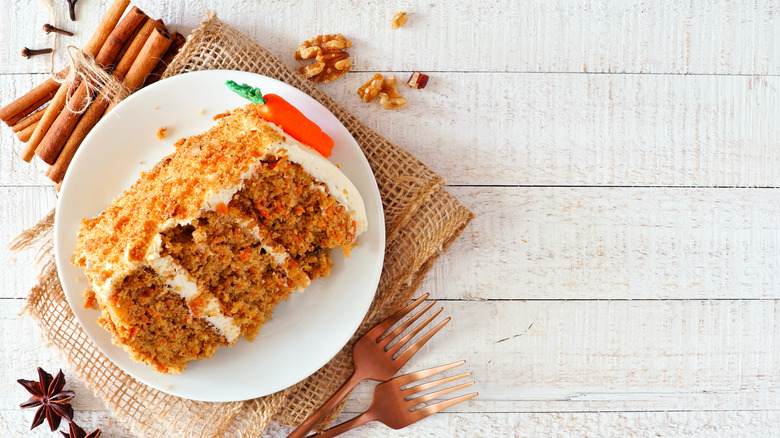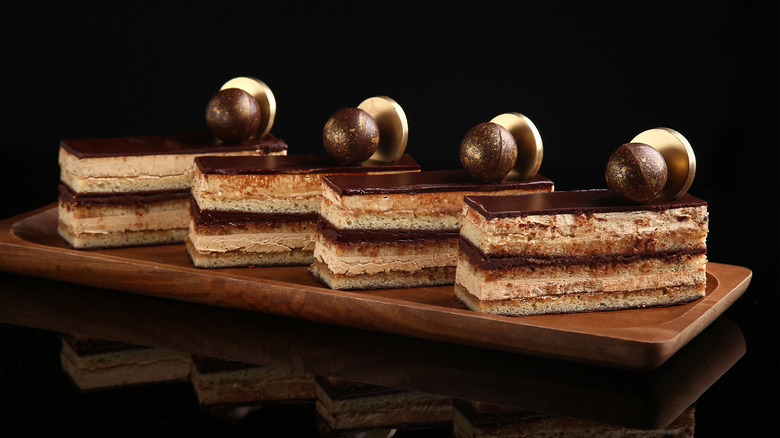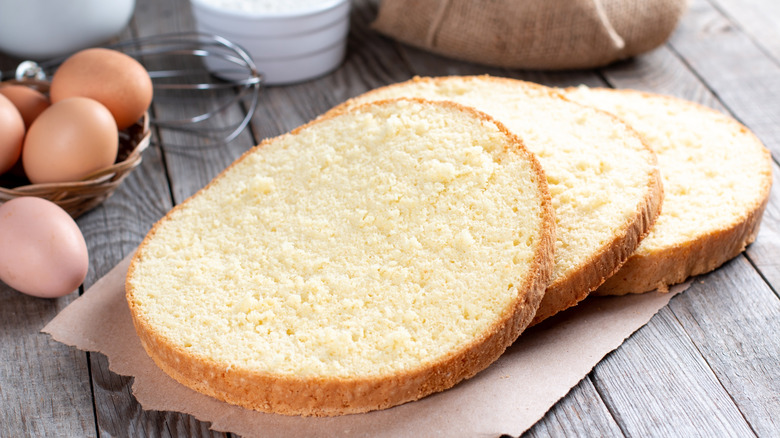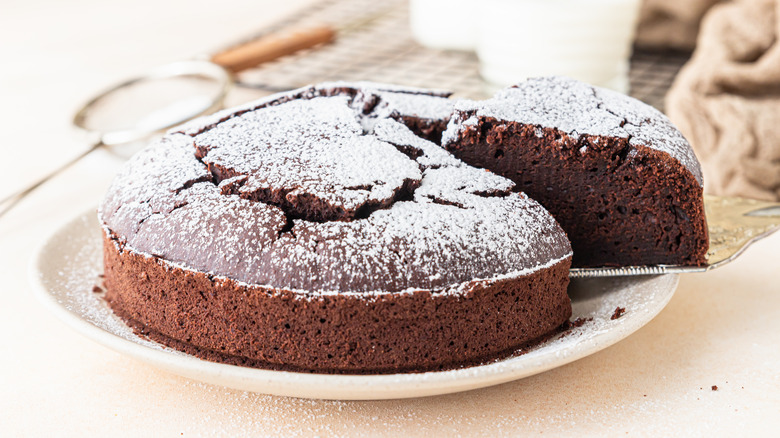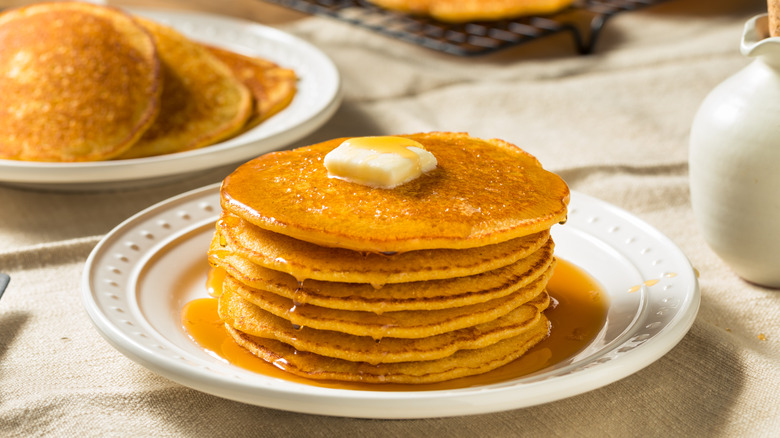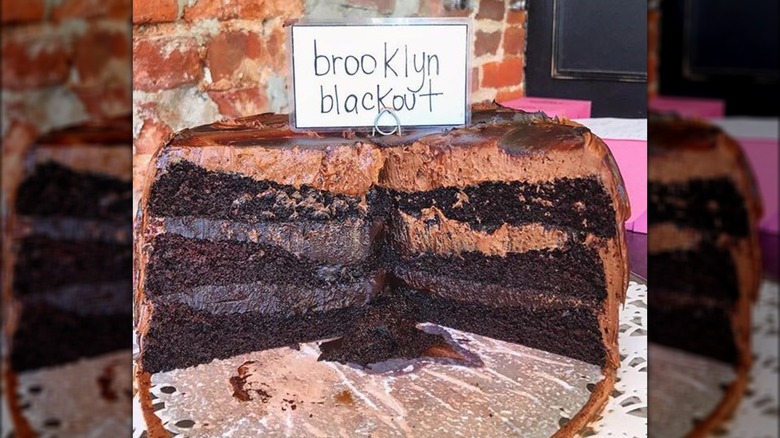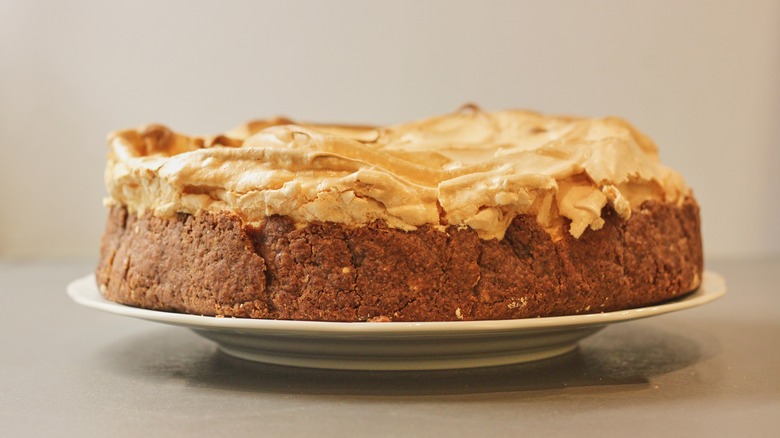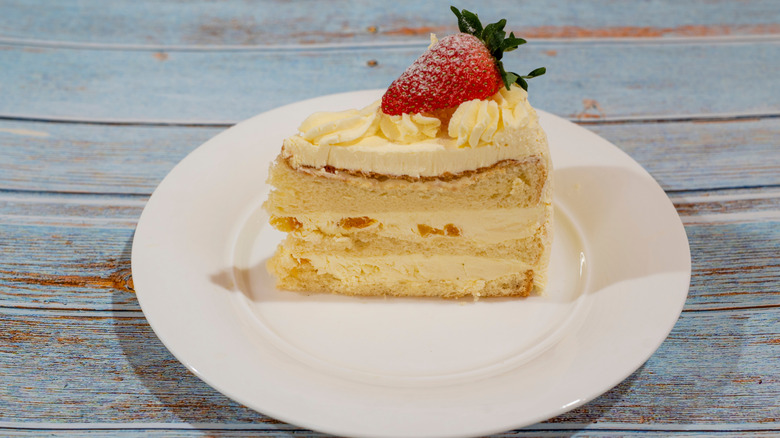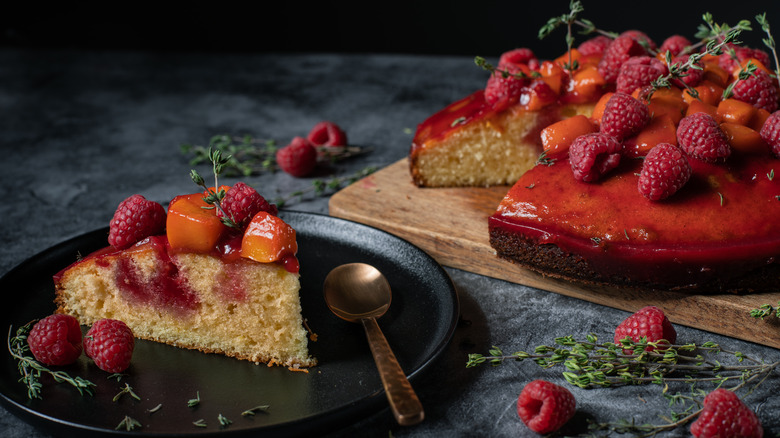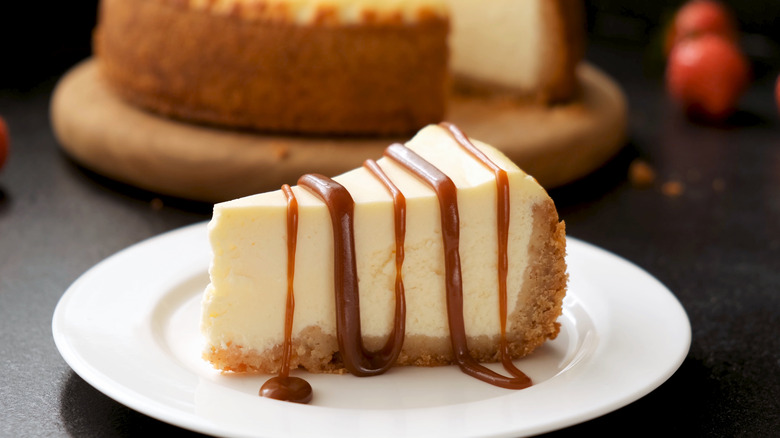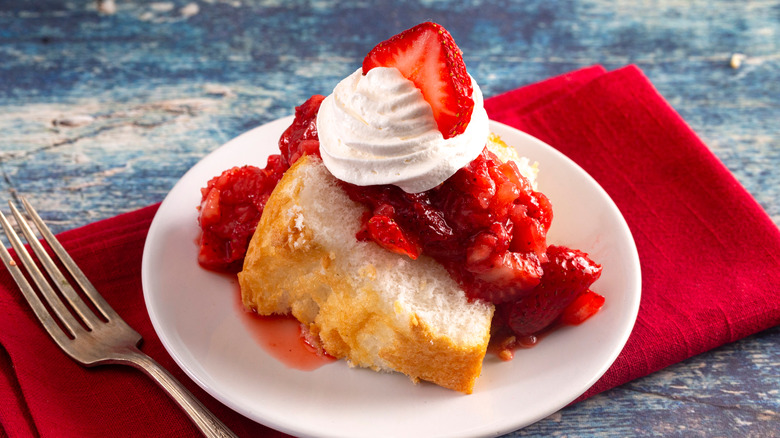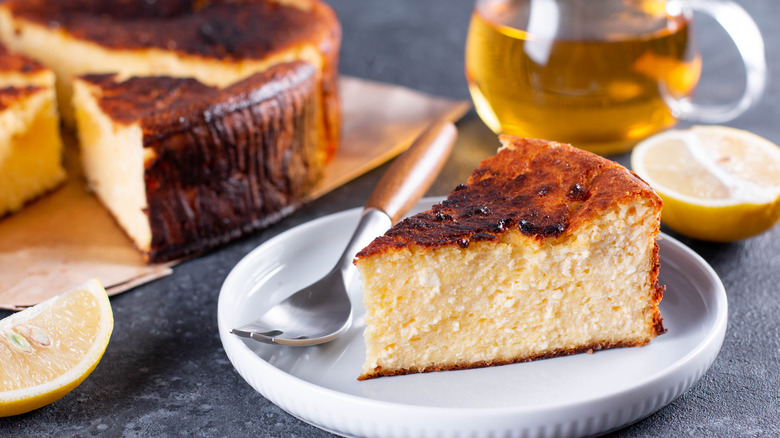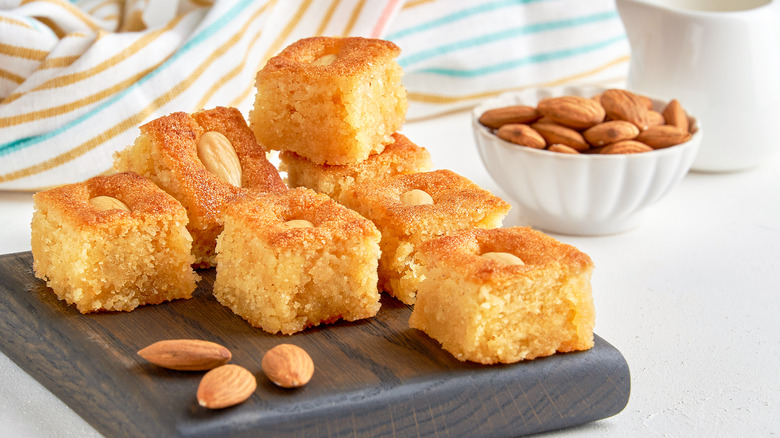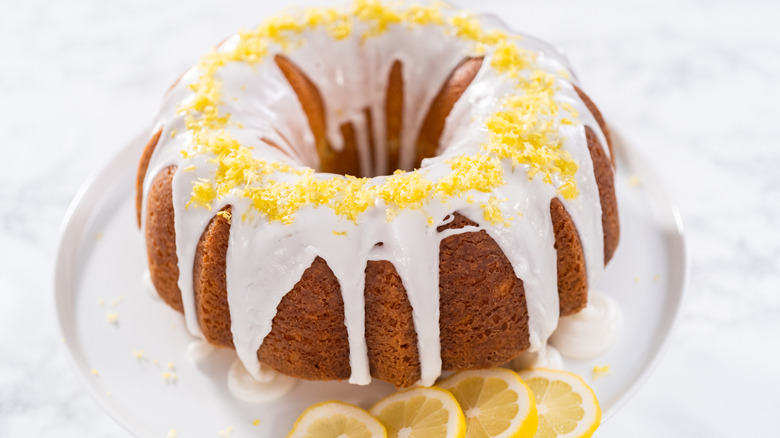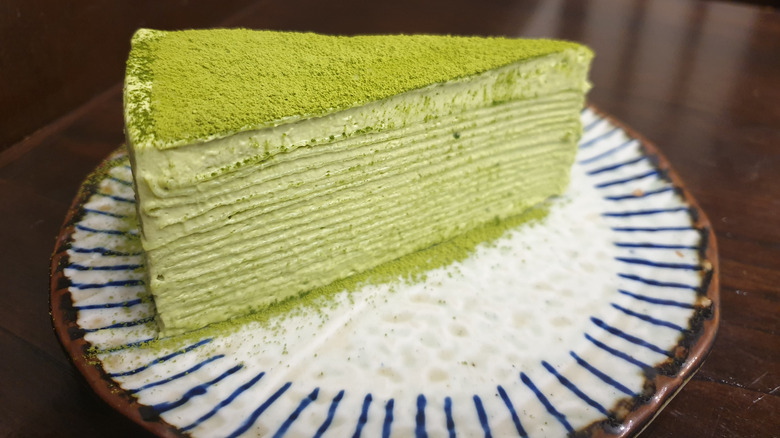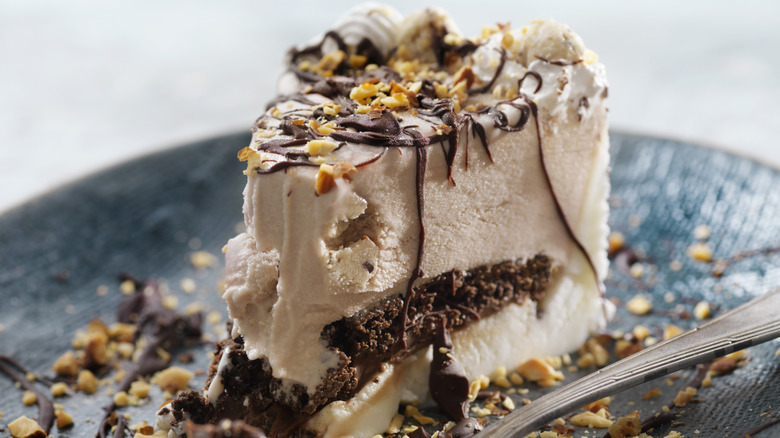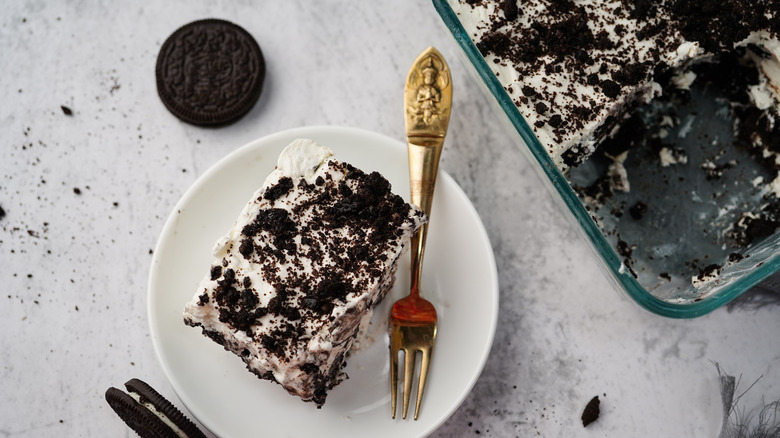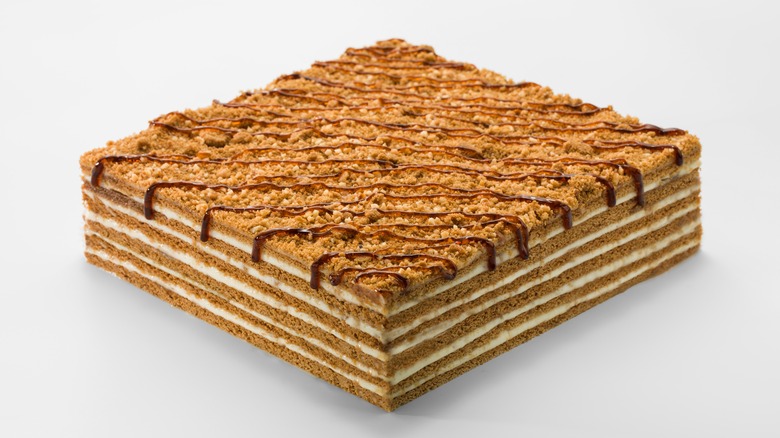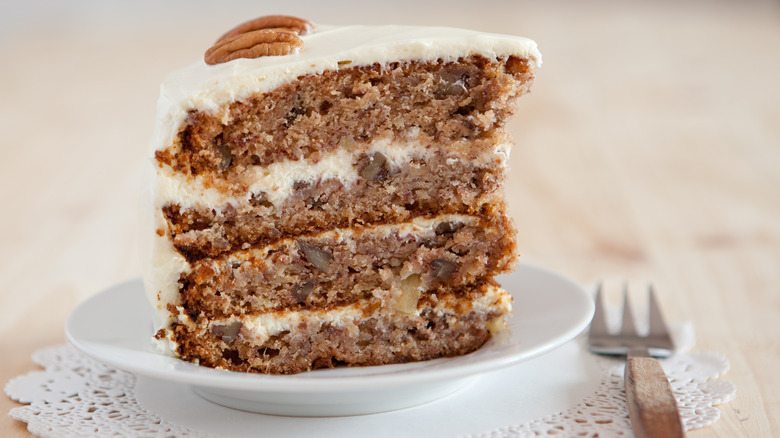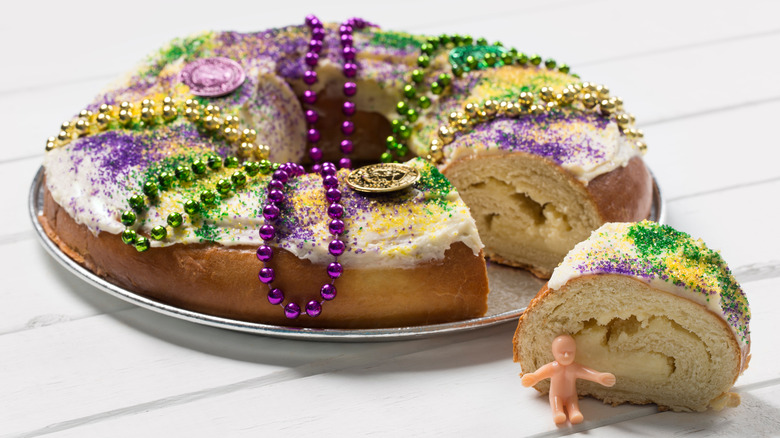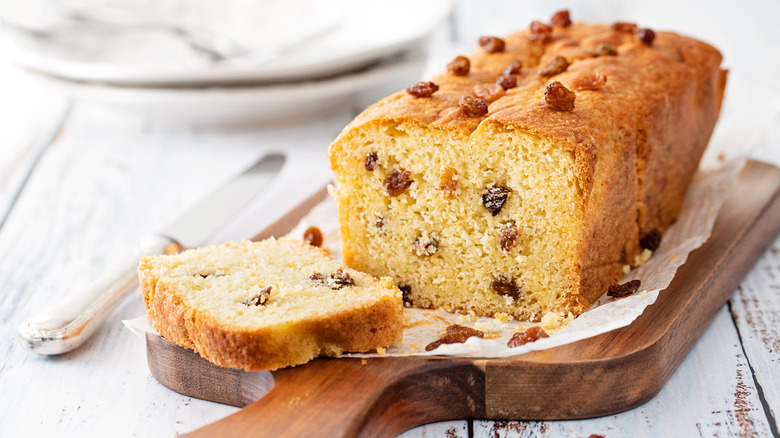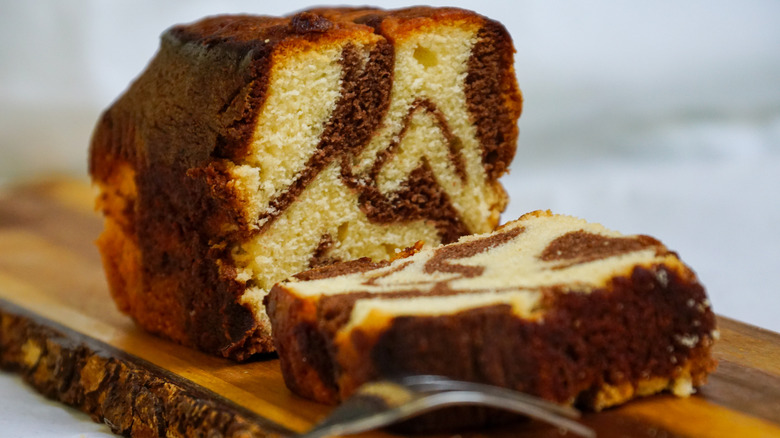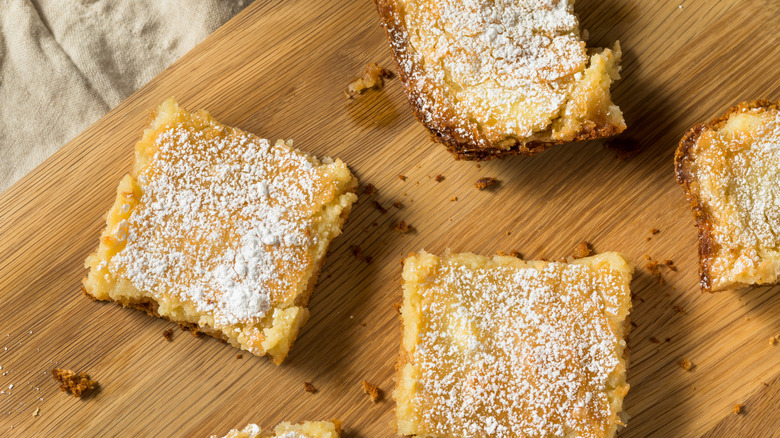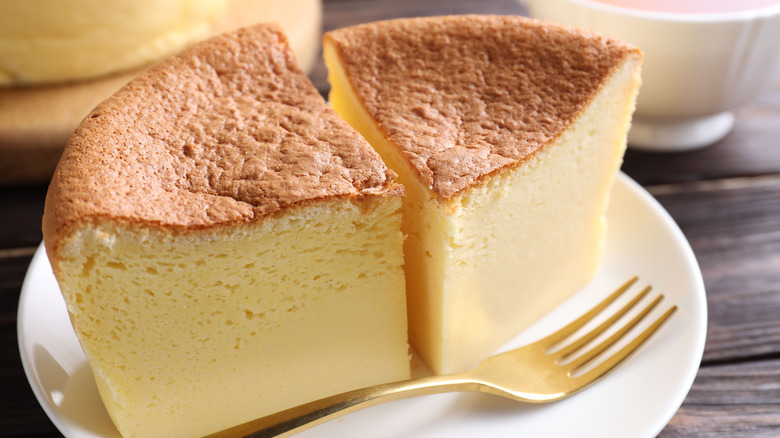34 Types Of Cake, Explained
Cake is a popular dessert across the globe. Americans alone spend tens of billions of dollars on various types of cake every year. The ancient Egyptians were the first society to figure out that the natural yeast floating around in the environment was the key to making their dough rise. The first cakes were descendants of yeasted bread risen on hot stones. The modern cake began to take shape in the 19th century with the invention of leavening agents like baking soda and baking powder — as well as the increased affordability of sugar and conventional home ovens.
Like other regional cuisines and dishes, cakes are shaped by the cultures and ingredients that surround them. Here are some of the most popular cakes and what makes them unique!
Red velvet cake
Red velvet cake has endured as one of the most popular cakes in the United States. The cake's name is a descriptor of its soft, velvety texture. The color, which is not as commonly observed in other cake types, was originally derived from raw cocoa powder. Raw cocoa powder began appearing in the 1800s and contains high levels of anthocyanin; a bright pigment that turns foods blue, purple, or red in the presence of an acid. The first red velvet cakes were baked with buttermilk, which has enough acid to interact with the anthocyanin and produce a distinct burgundy hue. During World War I, many bakers were forced to turn to grated beets or baked juice when eggs and milk were in short supply. This further brightened the red color of the cake.
Color additives became widely used after receiving approval from the Food & Drug Administration in the 1930s.The Adams Extract company used the authorization as a way to promote its red food coloring. The company published a recipe for the "Adams Red Velvet Cake" shortly afterward.
Pineapple upside-down cake
The pineapple upside-down cake is a retro baking classic. Societies have cooked with cast-iron skillets over open flames for hundreds of years. For a sweet treat, early societies would add sliced fruit to the bottom of the pan, pour on the batter, and flip the cake over once it was finished. Since early cast-iron pans featured tiny "spider legs," fruit upside-down cakes were dubbed "spider cakes."
Pineapple became more popular in America with the establishment of the Hawaiian Pineapple Company (now Dole). This tart cake is the perfect addition for family gatherings and holidays.
Black Forest cake
The Black Forest cake got its name from a sour cherry brandy called Schwarzwalder kirschwasser (kirsch) developed in the Black Forest region of Germany. Traditionally, a sour cherry brandy was used to soak the Black Forest cake. In fact, the Black Forest gateau (as it is known in Great Britain) was granted "protected status" by the European Union in 2016. This means that Black Forest cake can only be called such if the kirsch is derived from the Black Forest region of Germany.
Typically, Black Forest cake is made by soaking the chocolate sponge in sugar syrup flavored with cherry brandy and topped with whipped cream. The German variation of Black Forest cake uses buttercream, while Austrians make theirs with whipped cream, gelatin, and cornstarch.
Cupcakes
Cupcakes are a uniquely American dessert. The first reference to the dessert may have been in a cookbook from 1796, calling it "a cake baked in small cups." Another possibility is that cupcakes may have been referred to as a measurement technique memorized in volumes — similar to the pound cake. During the 18th century, queen cakes were also common; these individually portioned cakes were easily distributed and without the need for utensils.
Commercial paper cupcake liners became widely distributed in the 1950s by the James River Corporation. The first cupcake bakery, Sprinkles Cupcake, opened in 2005, and Sprinkles now sells over 45,000 cupcakes daily. Cupcakes in general come in almost every flavor as traditional cakes, so you can customize your batch to your liking.
Coffee cake
Coffee cake is likely a descendant of the Danish tradition of eating sweet breads while drinking morning coffee. After coffee was introduced to the European continent in the 1600s, Scandinavians and Germans started pairing coffee with sweet breads stuffed with nuts, fruits, and spices. Dutch and German immigrants brought the "coffee cake" to the United States in the late 1800s. In the 1870s, bakers in New York, New Jersey, and Delaware started adapting the coffee cake into more of a pastry than bread. Then, in the 1950s, bakers began making coffee cakes in bundt pans to better support a heavier batter and heavy streusel topping.
Modern coffee cake can be made with a variety of toppings, icing, fruits, and nuts. Turkish coffee cake is flavored with bittersweet chocolate, espresso powder, pomegranate molasses, and cocoa powder and covered in a bittersweet chocolate ganache.
Angel food cake
The angel food cake is a light, airy cake made with an absurd amount of eggs. It is categorized as a "foam cake" because it derives its structure from heavily beaten egg whites rather than oil, yolks, or butter. Angel food cake is highly versatile. Although vanilla is the most traditional flavor, bakers can substitute citrus or almond extracts, as well as add unsweetened cocoa powder for a chocolate angel food cake. Cinnamon, nutmeg, and cloves can be used for a spiced undertone to angel food cake.
For an ideal light texture, use sifted ingredients and caster sugar rather than granulated sugar. A stand mixer is also a handy appliance when making an angel food cake because it provides consistent movement when fluffing up meringues. You'll want to ditch the stand mixer when you're ready to fold the egg whites into the batter, though; using a stand mixer may beat the air out of the angel food cake and render it dense.
Devil's food cake
There are major differences between chocolate cake and devil's food cake. Devil's food cake has a dense texture and derives its structure from vegetable oil. Unlike its foil, angel food cake, devil's food cake utilizes leavening agents like baking soda and baking powder to rise. Some devil's food cake recipes add coffee to boost the chocolate flavor.
Like other cakes, devil's food cake can be adapted based on desired flavor profiles and the availability of other ingredients. There is some evidence that shredded beets were added to the first devil's food cake recipes to add moisture and sweetness; this makes the devil's food cake a precursor to the popular red velvet cake. Grated orange rind pairs well with the dark chocolate flavors without making the batter too wet.
Pound cake
The history of the pound cake is relatively simple. In 18th-century Britain, illiterate home bakers relied on memorized recipes to produce consistent bakes. Classic pound cake is made of a few simple ingredients: butter, sugar, eggs, and flour. The bakers used a pound of each to make the original pound cake recipe. Pound cake eventually made its way to the southern United States and became a baking staple for many households.
Modern iterations of the pound cake recipe profile new flavors and textures. Chef Stephanie Prida's recipe for olive oil pound cake with glazed apples utilizes oil instead of butter with the addition of chopped walnuts, brandy, and cider-glazed apples. Rhubarb pound cake maintains its soft texture via Greek yogurt and its flavors through the addition of ground cardamon, sliced rhubarb, and orange zest. The black tea cream on top of this springtime pound cake is delectable and one you'll want on your kitchen table.
Sponge cake
Sponge cake was the mother of many modern cake styles. The primary difference between a sponge cake and an angel food cake is that sponge cake uses both the whites and the yolks of eggs, while angel food cake only uses egg whites.
Italian sponge cake is made with three simple ingredients: room temperature eggs, granulated sugar, and low-protein flour. The recipe can be modified to include extracts — lemon, for example, is the most traditional flavor used in Italian baking. Similar to working with angel food cake, the baker must be sure not to beat the air out of the batter before it is baked.
Genoise sponge cake
Genoise sponge cake is enriched with butter and egg yolk, as well as flavored with a brush of flavored syrup. Adding the perfect brush of syrup rather than sopping the cake is the key to creating a flavorful, yet light sponge that can be layered in a torte.
The genoise sponge cake is a frequent flyer on "The Great British Bake Off." Self-proclaimed "queen of cake" Mary Berry had bakers make mockatines on Season 6, Episode 8's technical round. These small genoise sponge cakes are flavored with coffee icing and a crème beurre au moka: a French coffee icing. Prue Leith's Le Gâteau Vert appeared a few seasons later; this cake is filled with a pistachio-flavored genoise sponge and covered with pistachio marzipan and a spinach-based, boozy crème au beurre.
Carrot cake
According to Alan Davidson's "Oxford Companion to Food," carrots have been used in baking since the Middle Ages, when conventional sweeteners were otherwise scarce. Carrots continued to be used in recipes for Christmas puddings and cakes up until World War II.
Carrot cake can be filled with a variety of fruits, nuts, and flavors. The base flour can be substituted for whole wheat flour for a nuttier and more fibrous flavor. Adding fruits like pineapple can lessen the need for added sugars in the cake while providing a tropical flair to your carrot cake.
Opera cake
Opera cake is a traditional French dessert with three layers: almond sponge, espresso buttercream, and chocolate ganache. This type of cake was named after French pastry chef Cyriaque Gavillion's wife, who said that his chocolate creation resembled the Paris Opera House.
The sophisticated layers of this cake are integral to getting every flavor in each bite. The flour is traditionally made of a mix of almond flour and white pastry flour. This combination gives the cake its nutty undertone. Moreover, a boozy layer of espresso-brandy syrup is soaked into the cake for flavor before the entire cake is covered in the espresso buttercream and delicate chocolate ganache.
Chiffon cake
Unlike sponge cake, chiffon cake uses vegetable oil and baking soda for texture and rise. These ingredients give chiffon cake a comparatively heftier bake than a sponge cake. Harry Baker, corporate father of the General Mills company, has been credited for deriving the chiffon cake recipe to include vegetable oil instead of industrial shortening. This new style of baking was further marketed by Betty Crocker, a subsidiary of General Mills.
Chiffon cake is most commonly associated with citrus flavors. Orange, almond, chocolate, and coconut are four of the most popular chiffon cake flavors; the citrus notes are accented by a light, fluffy batter.
Flourless chocolate cake
Flourless chocolate torte cake is a gluten-free favorite prepared and baked in less than an hour. The recipe combines dark chocolate, almond meal, eggs, and butter together for a dense, chocolatey slice that pairs well with mascarpone, cream, or fresh fruit slices.
Chef Nigella Lawson's grown-up spin on flourless chocolate cake combines the same ingredients with the added nuttiness of chopped pistachios, rosewater, and softened pears. The pears provide a significant amount of moisture to the cake without significantly skewing its flavor. This recipe can be made quickly in a food processor and baked in under an hour for an elaborate celebration or post-dinner treat.
Johnnycakes
This centuries-old recipe is made from a simple mix of cornmeal, water, and salt and fried on a hot griddle. The origin of johnnycakes is up for debate, but it likely has Native American roots. The dish has become a staple in New England and it also popular in the South, where it is referred to as hoe cakes.
Both savory and sweet adaptations of johnnycakes exist. Chef Gabe Kennedy's charred corn johnnycakes with peach compote bring the flavors of a New England summer together with a tinge of mint mascarpone on top. Johnnycakes can also be served with syrup and butter (a la pancakes) or fresh fruit.
Brooklyn blackout cake
The Brooklyn blackout cake was the brainchild of the Ebinger Baking Company. This chocolate cake has a chocolate pudding filling with a pudding and chocolate-piece frosting. It was named after blackout drills during World War II, in which the borough of Brooklyn would run emergency procedures that effectively "blacked out" the city.
Although the bakery shut its doors in 1972, home bakers can still rejoice in the chocolate wonder that is the blackout cake. Some recipes amplify the chocolate flavors in the cake with the use of instant coffee. Buttermilk can be used as a leavening agent (in tandem with baking soda) to keep the cake moist.
Apple cake
The apple cake has numerous connections to German culture. In German, the cake is known as apfelkuchen (which literally means "apple cake") and includes warming spices like cinnamon and nutmeg. However, others attribute apple cake to Polish and Jewish culture as it originally did not contain dairy or meat products (that would have been prohibited under Kosher guidelines). The Jewish apple cake contains oil instead of butter, which both slows spoilage and makes the apple cake pareve.
Apple cake can be as simple or as complex as a baker desires. Spiced apple cake can play on the traditional fall flavors of apples, nutmeg, and cinnamon within a soft, sponge cake. The batter, made from traditional sponge cake ingredients and sour cream, is spooned into a nine-inch cake pan before being topped with softened Granny Smith apples. A layer of walnuts or pecans is also recommended for a nutty flair.
Asian fruit cream cake
The fruit cream cake is a staple for birthdays, anniversaries, and Christmas celebrations in both Japanese and Korean cultures. Unlike the cakes commonly seen in American bake shops, the fruit cream cake is not as sweet or as dense.
The sponge cake is often flavored with sweet cream, jam, and fresh fruit –- making it a light counterpart to an often-filling main course. Some recipes may utilize a soft sponge layer, custard filling, and whipped topping that's stabilized with gelatin for a soft dessert experience. The cake is often artistically decorated with sliced strawberries, blueberries, and grapes for a summery, fresh garnish.
Poke cake
Poke cake seems like a dessert straight out of the 1970s -– or a college dorm room. Poke cakes are made by poking small holes in the top of a baked cake and adding a layer of flavored gelatin or pudding. For a sweet retro treat, a poke cake recipe may use a classic vanilla boxed cake mix and strawberry or raspberry Jello. To make this cake, simply bake and prepare the mix as directed on the box before poking ½-inch holes into the cake and pouring the prepared Jello mixture over it. After the cake has solidified, it can then be topped with a tub of whipped cream and served.
Other recipes may recommend making a chocolate poke cake using boxed devil's food cake mix and chocolate pudding instead of Jello. Once the cake is prepared, simply top with chopped candy bars, chocolate shavings, or fresh fruit!
Cheesecake
Cheesecake was invented by the Greeks in the fifth century. The cheese itself is made of soft cheese, eggs, sugar, and flavoring, while the cake is made of a cookie or pastry base. The cake can be either raw, such as the French cheesecake, or baked, such as the New York cheesecake. Although cream cheese is the commonly used soft cheese in cheesecake, ricotta, quark, and cottage cheese can be used in other variations.
Cheesecake can come in a variety of flavors. A no-bake chocolate cheesecake contains cream cheese, sour cream, melted semi-sweet chips, and a pre-made graham cracker crust. These ingredients keep the custard moist and delicious — especially with a sprinkle of flaky sea salt on top. Cheesecake can also be served with fresh fruits like cherries, blueberries, or strawberries.
Strawberry shortcake
Strawberry shortcake has a deep history in early America and has undergone significant change over time. Indigenous groups mixed strawberries and corn to make a strawberry cake, and it is believed that the colonizers replicated this dessert in the form of a shortcake.
The first shortcake recipe was published shortly afterward in 1847. The "Miss Leslie's Ladies Receipt Book" from the 1850s contains a recipe for "Strawberry Cake" with mashed strawberries and icing. Over time, whipped cream replaced the butter icing, and the cake component of the recipe took on regional textures; Southern shortcake resembles more of a crusty biscuit, while Northern shortcake has a cakey, soft texture. This strawberry shortcake recipe is a grown-up twist on the traditional dessert with cognac-macerated strawberries, mascarpone, and toasted almonds.
Basque cheesecake
The Basque cheesecake is similar to its Americanized counterpart except for one important component: the crust! The Basque cheesecake is crustless, so it is dependent on a naturally hot oven to caramelize a crust layer.
The La Viña cheesecake from the San Sebastián region of Spain is made of heavy cream, sugar, cream cheese, egg, flour, and vanilla; this is one of the most traditional Basque cheesecake recipes. However, you can get inventive with some flavorful twists on the original, such as with strawberry or chocolate variations of the recipe. These cheesecakes can be garnished with fruit or cream and served at almost any event or gathering.
Basbousa
Basbousa is a Middle Eastern semolina cake flaked with coconut and soaked in syrup; its reach extends to North African and Western Asian countries, as well. The soaking syrup can take on a variety of flavors including lemon, rose water, or orange blossom water. The cake is typically eaten around Ramadan, the holy fasting period for Muslims. Basbousa's taste has been described as tender, crumbly, and similar to that of American cornbread.
Basbousa can include a variety of flavors and regional ingredients. In Egypt, basbousa frequently contains almond powder and a hazelnut topping. In Syria and Lebanon, basbousa is often made with crushed pistachios and flavored with coconut or candied orange peel.
Bundt cake
Bundt cakes are less about what's in them and more about their shape. According to chef Alton Brown, ensuring that the batter does not stick to the walls of the doughnut-shaped mold is essential to getting the perfect bundt shape. He recommends coating the bundt pan with butter and a layer of flour before covering the pan with plastic wrap and vigorously shaking it. This ensures all corners of the pan are covered and will prevent your bundt from sticking.
Bundt cakes are popular at all times of the year, but most are made and elaborately decorated during the holidays. Glaze, icing, and garnishes give bundt cakes their intricate appearance. Recipe developer Jessica Morrone recommends baking her moist chocolate zucchini cake in a bundt pan for a crispy edge — and it's the perfect canvas for intricate decoration.
Mille crepes cake
Mille crepe translates to "one-thousand crepes" in French. Although, that is a bit of an exaggeration — the average mille crepe cake contains between 15 to 30 layers of crepes sandwiched between layers of sweet, thin filling. Some of the mille foil cakes also have a frosting layer on the exterior of the cake with elaborate piping.
These intricate cakes come in a variety of flavors, such as tiramasu birthday cake made with a mascarpone and sweet marsala wine filling. You could even combine mango puree and cream with several layers of crepes for a tropical twist on the mille crepe cake.
Ice cream cake
Ice cream cake is a nostalgic childhood creation that combines the best desserts out there: ice cream and cake. Ice cream cakes are typically assembled by layering ice cream and cake with chocolate, fruit, or candy. Ice cream cakes can come in a variety of themes and flavors that inspire creativity and imagination.
A traditional Spumoni ice cream cake is made from the Italian flavors of pistachio, cherry, and chocolate ice cream along with the crunch of a chocolate waffle cone crust. S'mores ice cream cake combines decadent layers of homemade marshmallows, chocolate graham crackers, vanilla ice cream, and chocolate ice cream for a frozen campfire classic.
Icebox cake
Unlike ice cream cakes, icebox cakes do not include ice cream or cake. Instead, icebox cakes are no-bake desserts made with layers of wafer cookies and whipped topping and set in a refrigerator (it's also sometimes referred to as dirt, due to its appearance). Icebox cakes are popular among home bakers because they are infinitely customizable with fruit, cookies, and toppings.
Icebox cakes are an excellent type of "cake" to make with kids in the kitchen because they require minimal cooking equipment (if any). A simple salted caramel icebox cake contains four simple ingredients: heavy cream, caramel sauce, salt, and chocolate wafer cookies. The icebox cake firms up in the refrigerator in at least three hours and is ready to serve when it comes out.
Honey cake
Honey cake is commonly served on Rosh Hashanah, the Jewish New Year. The Russian version of the recipe, medovik, dates back to Emperor Alexander I.
Honey cake is a recipe sweetened with, you guessed it, honey. This simple honey cake recipe derives its moisture from Greek yogurt, eggs, and unsalted butter. The recipe can either be made in a cast-iron skillet or a nine-inch cake pan. The skillet has some advantages for honey cake because it increases the crusty surface area while keeping the inside of the cake moist. The cake is finally garnished with fresh fruit and chopped pistachios.
Hummingbird cake
The hummingbird cake recipe was first submitted to the publication Southern Living in 1978. It is now one of its most popular recipes! The hummingbird cake derives its moisture from vegetable oil and canned pineapple chunks, which are added to the batter with the can's liquid. Besides the tropical essence of pineapple, the cake also contains bananas, chopped pecans (roasted for a better flavor), and a layer of cream cheese frosting.
Hummingbird cake can also be made in a loaf pan, such as this hummingbird loaf cake recipe. The cake is made with the same flavors as a frosted hummingbird cake — just topped with a pecan oat streusel and vanilla glaze.
King cake
King cake is a staple of the Mardi Gras tradition. The cake, which can be made into a circular loaf or a braided ring, is just as extravagant as the Mardi Gras celebration. The cake is decorated in purple, green, and gold sugar; these colors are symbolic of power, faith, and justice and were designated by the Rex parade in 1892. The last important element of the king cake is the inclusion of a small trinket inside (often a plastic baby). It is said that whoever chooses the piece with the trinket is king for that day — and responsible for purchasing or making the cake for the following year's Mardi Gras celebration.
Although you can make king cake at home with colored sprinkles, white vanilla icing, and sweet dough, it is a much better idea to place an online cake order at one of New Orleans' king cake bakeries for the occasion. Although these bakeries have different takes on the king cake recipe, they all emulate the extravagance of the king cake tradition.
Fruitcake
Fruitcake is a divisive treat with a name that leaves nothing to the imagination. Its earliest form, which popped up in Europe and was called plumb cake, was composed of a very dense sponge with dried and candied fruit. As time went by, a whole host of different fruits started appearing in recipes, including currants, raisins, and apricots, along with alcohol (often in the form of brandy- or wine-soaked fruit or sponge), warming spices like cinnamon and nutmeg, and aromatic infusions like rosewater.
There are two common variations of fruitcake today: light and dark fruitcake. The former, as its name suggests, is made with lighter-colored ingredients and fruits, while the latter packs in heavy molasses and brown sugar, along with dried cherries, prunes, and nuts. The main reason why some people don't like fruitcake's distinctive flavor is citron, a candied fruit peel, though this ingredient can be excluded from the recipe if desired. This type of cake is quite heavy and dense, making it a popular one during the holiday season.
Marble cake
Marble cake is all about the looks. It's made by gently stirring two different colors of batter together, often vanilla and chocolate or vanilla and coffee, to produce a lava lamp-like, swirled effect. Marbling is more of a technique than a type of cake, seeing that it can be done with cupcakes, coffee cakes, sponge cakes, or even quick breads.
You can marble a cake with a spoon, or, depending on the size of the cake itself, just a toothpick. Simply drop in blobs of one batter into the other and swirl them together. You can decorate marble cake with many different kinds of frostings (bonus points if it's a chocolate and vanilla swirl, as well) and bake it in whatever shaped pan you'd like.
Gooey butter cake
Residents or folks who have visited the Gateway to the West (St. Louis) will likely recognize this type of cake. Gooey butter cake is a regional bake that has mysterious origins. While some say that it was intentionally created, others argue that it was the result of a coffee cake gone wrong. Despite its contested history, there's no denying that this is one of the most flavorful vanilla "cakes" you'll ever eat. It has a yeasted crust with a custardy soft filling that's barely set — hence the "gooey" moniker. Some bakers have abandoned the yeasted crust entirely, instead opting for a more blondie-like shell and a custardy, cream cheese-infused interior. Butter cake is typically served in squares, rather than cut into triangular slices.
There are tons of variations of this recipe that incorporate novel flavors, including ones made with brown butter, which intensifies the vanilla flavor even more. Chocolate lovers can get in on the fun, too; our recipe for chocolate gooey butter cake is like the lovechild of a molten brownie and chocolate cake.
Japanese castella cake
"Bouncy" is probably not a word you want to use to describe your cake — unless, of course, you're making Japanese castella cake. This sweet is commonly enjoyed as a mid-afternoon snack in Japan. It's not overtly sweet, as is the case with many other Asian desserts, and may also be called kasutera. The cake was first made in 1543, around the same time that Portuguese merchants and missionaries began appearing in the Nagasaki region. Its name is a nod to pão de Castela — or, "bread of Castille." The arrival of sugar to the island nation, as well as Portuguese influence on regional cuisine, led to the creation of this pillowy, soft cake, which is flavored with honey.
Japanese castella cake does not contain chemical leaveners like baking soda and baking powder; it's entirely dependent on whipped egg whites for its signature lift and puffy texture. Many recipes will also call for a starchy sugar called mizuame, which helps the cake stay moist. Besides a sprinkle of powdered sugar, this cake is usually enjoyed without a garnish or frosting.
